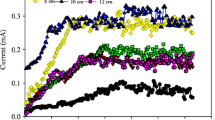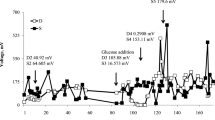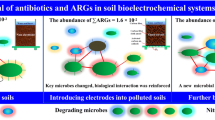Abstract
The microbial fuel cell (MFC) that uses a solid electrode as the inexhaustible electron acceptor is an innovative remediation technology that simultaneously generates bioelectricity. Chlorinated pollutants are better metabolized by reductive dechlorination in proximity to the cathode. Here, the removal efficiency of the herbicide metolachlor (ML) increased by 262 and 176% in soil MFCs that were spiked with 10 (C10) and 20 mg/kg (C20) of ML, respectively, relative to the non-electrode controls. The bioelectricity output of the C10 and C20 increased by over two- and eightfold, respectively, compared to that of the non-ML control, with maximum current densities of 49.6 ± 2.5 (C10) and 78.9 ± 0.6 mA/m2 (C20). Based on correlations between ML concentrations and species abundances in the MFCs, it was inferred that Azohydromonas sp., Sphingomonas sp., and Pontibacter sp. play a major role in ML removal around the cathode, with peak removal efficiencies of 56 ± 1% (C10) and 58 ± 1% (C20). Moreover, Clostridium sp., Geobacter sp., Bacillus sp., Romboutsia sp., and Terrisporobacter sp. may be electricigens or closely related microbes due to the significant positive correlation between the bioelectricity generation levels and their abundances around the anode. This study suggests that a directional adaptation of the microbial community has taken place to increase both the removal of chlorinated herbicides around the cathode and the generation of bioelectricity around the anode in bioelectrochemical remediation systems.








Similar content being viewed by others
References
Accinelli C, Dinelli G, Vicari A, Catizone P (2001) Atrazine and metolachlor degradation in subsoils. Biol Fertil Soils 33:495–500
Adamczyk B, Kitunen V, Smolander A (2009) Polyphenol oxidase, tannase and proteolytic activity in relation to tannin concentration in the soil organic horizon under silver birch and Norway spruce. Soil Biol Biochem 41:2085–2093
Arora PK, Sasikala C, Ramana Ch V (2012) Degradation of chlorinated nitroaromatic compounds. Appl Microbiol Biotechnol 93:2265–2277
Bardot C, Besse-Hoggan P, Carles L, Le Gall M, Clary G, Chafey P, Federici C, Broussard C, Batisson I (2015) How the edaphic Bacillus megaterium strain Mes11 adapts its metabolism to the herbicide mesotrione pressure. Environ Pollut 199:198–208
Borah D, More S, Yadav RNS (2013) Construction of double chambered microbial fuel cell (MFC) using household materials and Bacillus metaterium isolate from tea garden soil. J Microbiol Biotechnol Food Sci 3:84–86
Cao X, Song H, Yu C, Li X (2015) Simultaneous degradation of toxic refractory organic pesticide and bioelectricity generation using a soil microbial fuel cell. Bioresour Technol 189:87–93
Cao X, Yu C, Wang H, Zhou F, Li X (2017) Simultaneous degradation of refractory organic pesticide and bioelectricity generation in a soil microbial fuel cell with different conditions. Environ Technol 38:1043–1050
Colman S, Linderman R, Hodgson E, Rose RL (2000) Comparative metabolism of chloroacetamide herbicides and selected metabolites in human and rat liver microsomes. Environ Health Perspect 108:1151–1157
Feng X, Zhu M, He Y (2017) Effects and mechanisms of soil redox processes on reductive dechlorination of chlorinated organic pollutants. Asian J Ecotox 12:151–161
Gundi VA, Viswanath B, Chandra MS, Kumar VN, Reddy BR (2007) Activities of cellulase and amylase in soils as influenced by insecticide interactions. Ecotox Environ Safe 68:278–285
Hartnett S, Musah S, Dhanwada KR (2013) Cellular effects of metolachlor exposure on human liver (HepG2) cells. Chemosphere 90:1258–1266
Huang D, Zhou S, Chen Q, Zhao B, Yuan Y, Zhuang L (2011) Enhanced anaerobic degradation of organic pollutants in a soil microbial fuel cell. Chem Eng J 172:647–653
Konstantinou IK, Hela DG, Albanis TA (2006) The status of pesticide pollution in surface waters (rivers and lakes) of Greece. Part I. Review on occurrence and levels. Environ Pollut 141:555–570
Li X, Wang X, Zhang Y, Cheng L, Liu J, Li F, Gao B, Zhou Q (2014a) Extended petroleum hydrocarbon bioremediation in saline soil using Pt-free multianodes microbial fuel cells. RSC Adv 4:59803–59808
Li X, Wang X, Zhang Y, Ding N, Zhou Q (2014b) Opening size optimization of metal matrix in rolling-pressed activated carbon air-cathode for microbial fuel cells. Appl Energy 123:13–18
Li X, Wang X, Ren ZJ, Zhang Y, Li N, Zhou Q (2015) Sand amendment enhances bioelectrochemical remediation of petroleum hydrocarbon contaminated soil. Chemosphere 141:62–70
Li X, Wang X, Wan L, Zhang Y, Li N, Li D, Zhou Q (2016a) Enhanced biodegradation of aged petroleum hydrocarbons in soils by glucose addition in microbial fuel cells. J Chem Technol Biotechnol 91:267–275
Li X, Wang X, Zhang Y, Zhao Q, Yu B, Li Y, Zhou Q (2016b) Salinity and conductivity amendment of soil enhanced the bioelectrochemical degradation of petroleum hydrocarbons. Sci Rep 6:32861
Li X, Wang X, Weng L, Zhou Q, Li Y (2017) Microbial fuel cells for organic-contaminated soil remedial applications: a review. Energy Technol 5:1156–1164
Liu G (1996) Soil physical and chemical analysis and description of soil profiles. Standard Press, Beijing
Liu H, Ye W, Zhan X, Liu W (2006) A comparative study of rac- and S-metolachlor toxicity to Daphnia magna. Ecotox Environ Safe 63:451–455
Logan BE (2009) Exoelectrogenic bacteria that power microbial fuel cells. Nat Rev Microbiol 7:375–381
Logan BE, Regan JM (2006) Electricity-producing bacterial communities in microbial fuel cells. Trends Microbiol 14:512–518
Logan BE, Hamelers B, Rozendal R, Schroder U, Keller J, Verstraete W, Rabaey K (2006) Microbial fuel cells methodology and technology. Environ Sci Technol 40:5181–5192
Lovley DR (2006) Bug juice: harvesting electricity with microorganisms. Nat Rev Microbiol 4:497–508
Lovley DR (2008) The microbe electric: conversion of organic matter to electricity. Curr Opin Biotechnol 19:564–571
Lovley DR (2011) Powering microbes with electricity: direct electron transfer from electrodes to microbes. Environ Microbiol Rep 3:27–35
Lu L, Huggins T, Jin S, Zuo Y, Ren ZJ (2014a) Microbial metabolism and community structure in response to bioelectrochemically enhanced remediation of petroleum hydrocarbon-contaminated soil. Environ Sci Technol 48:4021–4029
Lu L, Yazdi H, Jin S, Zuo Y, Fallgren PH, Ren ZJ (2014b) Enhanced bioremediation of hydrocarbon-contaminated soil using pilot-scale bioelectrochemical systems. J Hazard Mater 274:8–15
Morris JM, Song J (2012) Enhanced biodegradation of hydrocarbon-contaminated sediments using microbial fuel cells. J Hazard Mater 213-214:474–477
Mulla SI, Hu A, Wang Y, Sun Q, Huang S, Wang H, Yu C (2016) Degradation of triclocarban by a triclosan-degrading Sphingomonas sp. strain YL-JM2C. Chemosphere 144:292–296
Ng EL, Patti AF, Rose MT, Schefe CR, Wilkinson K, Cavagnaro TR (2014) Functional stoichiometry of soil microbial communities after amendment with stabilised organic matter. Soil Biol Biochem 76:170–178
Quejigo JR, Domínguez-Garay A, Dörfler U, Schroll R, Esteve-Núñez A (2018) Anodic shifting of the microbial community profile to enhance oxidative metabolism in soil. Soil Biol Biochem 116:131–138
Quilchano C, Marañón T (2002) Dehydrogenase activity in Mediterranean forest soils. Biol Fert Soils 35:102–107
Rabaey K, Willy V (2005) Microbial fuel cells: novel biotechnology for energy generation. Trends Microbiol 23:291–298
Santoro C, Guilizzoni M, Correa Baena JP, Pasaogullari U, Casalegno A, Li B, Babanova S, Artyushkova K, Atanassov P (2014) The effects of carbon electrode surface properties on bacteria attachment and start up time of microbial fuel cells. Carbon 67:128–139
Singh AK, Garg N, Lata P, Kumar R, Negi V, Vikram S, Lal R (2014) Pontibacter indicus sp. nov., isolated from hexachlorocyclohexane-contaminated soil. Int J Syst Evol Microbiol 64:254–259
Sinsabaugh RL (2010) Phenol oxidase, peroxidase and organic matter dynamics of soil. Soil Biol Biochem 42:391–404
Strycharz SM, Gannon SM, Boles AR, Franks AE, Nevin KP, Lovley DR (2010) Reductive dechlorination of 2-chlorophenol by Anaeromyxobacter dehalogenans with an electrode serving as the electron donor. Environ Microbiol Rep 2:289–294
Trigo C, Spokas K, Hall K, Cox L, Koskinen WC (2016) Metolachlor sorption and degradation in soil amended with fresh and aged biochars. J Agric Food Chem 64:3141–3149
Vryzas Z, Alexoudis C, Vassiliou G, Galanis K, Papadopoulou-Mourkidou E (2011) Determination and aquatic risk assessment of pesticide residues in riparian drainage canals in northeastern Greece. Ecotox Environ Safe 74:174–181
Wang X, Cai Z, Zhou Q, Zhang Z, Chen C (2012) Bioelectrochemical stimulation of petroleum 516 hydrocarbon degradation in saline soil using U-tube microbial fuel cells. Biotechnol Bioeng 517 109:426–433
Wang X, Feng C, Ding N, Zhang Q, Li N, Li X, Zhang Y, Zhou Q (2014) Accelerated OH− transport in activated carbon air-cathode by modification of quaternary ammonium for microbial fuel cells. Environ Sci Technol 48:4191–4198
Wang Y, Chen Z, Liu P, Sun G, Ding L, Zhu Y (2016) Arsenic modulates the composition of anode-respiring bacterial community during dry-wet cycles in paddy soils. J Soils Sediments 16:1745–1753
Wang H, Yi S, Cao X, Fang Z, Li X (2017) Reductive dechlorination of hexachlorobenzene subjected to several conditions in a bioelectrochemical system. Ecotox Environ Safe 139:172–178
Wei M, Harnisch F, Vogt C, Ahlheim J, Neu TR, Richnow HH (2015) Harvesting electricity from benzene and ammonium-contaminated groundwater using a microbial fuel cell with an aerated cathode. RSC Adv 5:5321–5330
Wolińska A, Stępniewska Z (2012) Dehydrogenase activity in the soil environment. In: Canuto RA (ed), Dehydrogenases, InTech. https://doi.org/10.5772/48294
Wu X, Li M, Long Y, Liu R, Yu Y, Fang H, Li S (2011) Effects of adsorption on degradation and bioavailability of metolachlor in soil. J Soil Sci Plant Nut 11:83–97
Xing D, Cheng S, Logan BE, Regan JM (2010) Isolation of the exoelectrogenic denitrifying bacterium Comamonas denitrificans based on dilution to extinction. Appl Microbiol Biotechnol 85:1575–1587
Zhang Y, Wang X, Li X, Gao N, Wan L, Feng C, Zhou Q (2014) A novel and high performance activated carbon air-cathode with decreased volume density and catalyst layer invasion for microbial fuel cells. RSC Adv 4:42577–42580
Zhao Q, Yue S, Bilal M, Hu H, Wang W, Zhang X (2017) Comparative genomic analysis of 26 Sphingomonas and Sphingobium strains: dissemination of bioremediation capabilities, biodegradation potential and horizontal gene transfer. Sci Total Environ 609:1238–1247
Funding
This study was financially supported by the Special Fund for Agro-Scientific Research in the Public Interest of China (No. 201503107-7), the Natural Science Foundation of Tianjin (No. 16JCQNJC08800), the National Natural Science Foundation of China (No. 41601536), the National Key R&D Program of China (No. 2017YFD0800704), the Opening Foundation of Ministry of Education Key Laboratory of Pollution Processes and Environmental Criteria (2017-05), and the Central Public-interest Scientific Institution Basal Research Fund.
Author information
Authors and Affiliations
Corresponding author
Ethics declarations
Conflict of interest
The authors declare that they have no conflict of interest.
Ethical approval
This article does not contain any studies with human participants or animals performed by any of the authors.
Informed consent
Informed consent was obtained from all individual participants included in the study.
Additional information
Responsible editor: Robert Duran
Rights and permissions
About this article
Cite this article
Li, Y., Li, X., Sun, Y. et al. Cathodic microbial community adaptation to the removal of chlorinated herbicide in soil microbial fuel cells. Environ Sci Pollut Res 25, 16900–16912 (2018). https://doi.org/10.1007/s11356-018-1871-z
Received:
Accepted:
Published:
Issue Date:
DOI: https://doi.org/10.1007/s11356-018-1871-z




